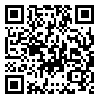BibTeX | RIS | EndNote | Medlars | ProCite | Reference Manager | RefWorks
Send citation to:
URL: http://ioh.iums.ac.ir/article-1-1569-en.html
Background and aims: Blood borne diseases are still one of the major sources of nosocomial infections and are large concern of health personnel because of extension of HIV infection and also transmission of Hepatitis B and C. The aim of this study was to determine the occurrence and risk factors of needle stick and sharps injuries among personnel of a university hospital.
Methods: In this cross sectional study, a total of 168 nurses, midwives, physicians, laboratory technicians, operation technicians, nurse aids, and anesthesia personnel, involved in the direct management and care of patients answered to questions about occurrence of needle stick and sharps injuries and some potential risk factors. The questionnaire including personal and occupational characteristics was assessed for validity and reliability.
Results: The rate of needle stick injury was 1.4 per person in a year. 42.9% of personnel had at least one needle stick injury in the last year. About 71 % of the participants had an experience of needle stick injuries and only 29% of these had not any injury from needle stick duration entire work career. Multiple logistic regression analysis showed that the most important risk factor for needle stick injuries was re-capping needles, (OR: 2.5, 95% CI 1.5- 4.8).
Conclusion: The rate of needle stick injuries is fairly high among health care personnel and there are concerns about transmission of blood borne diseases. Recapping needles is performing by many personnel. Besides the proper educations, it needs to provide safety devices to reduce such injuries.
Received: 2015/07/27 | Accepted: 2016/02/16 | Published: 2016/07/19
| Rights and permissions | |
 |
This work is licensed under a Creative Commons Attribution-NonCommercial 4.0 International License. |





